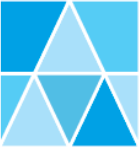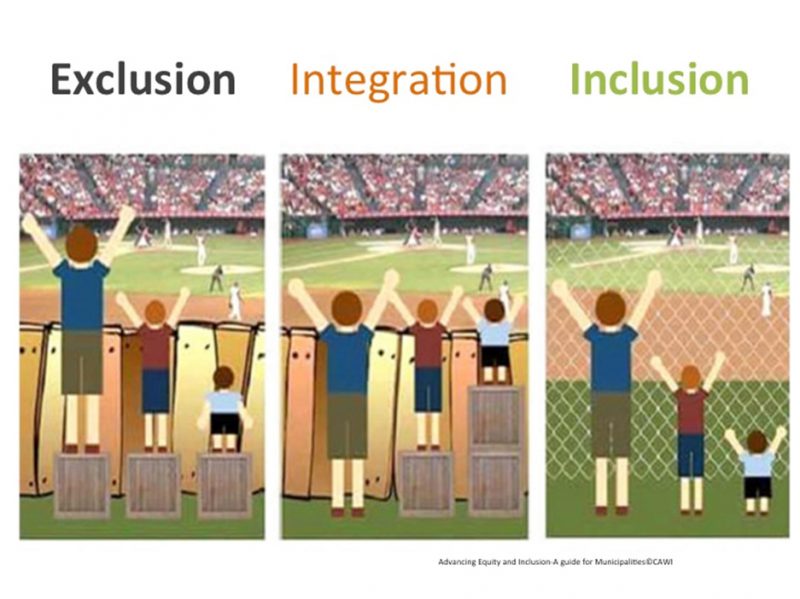Laure Galipeau and Catherine Soleil, faculty members of the French Department, and Effie Konstantinopoulos, a pedagogical counsellor at the Student AccessAbility Centre, conducted PAREA-funded research on the implementation of Universal Design for Learning (UDL) in a French course. They redesigned the course to take into account the diversity of students in the classroom and minimize potential learning barriers while still maintaining the same expectations of student achievement. We encourage you to delve into the realm of inclusion. Enjoy the UDL journey!
Our work began after 2011, when large numbers of students with learning disabilities, mental health disorders, and neurological difficulties began arriving at the college level. A growing awareness of the diversity of learners and the barriers to learning faced by this new population led us to reflect on our teaching practice and to rethink course content and the nature of learning assessments. A key notion that guided our reflection was the following: “What can be helpful for a student with learning disabilities can be helpful for other students” (Dubé, Sénécal, 2009).
The Universal Design for Learning (UDL) model, which seeks to improve and optimize teaching and learning for all people, answered our needs. Further, we recognized that variability is the norm, and that as an institution, and as individuals we can no longer allow ourselves to cater to a hypothetical standard, average student. [Todd Rose, The Myth of Average, TEDx, 2013]
In addition, a report from the Conseil supérieur de l’éducation traces the evolution of approaches taken by the Quebec educational system when responding to students’ different cognitive and learning abilities.
The Quebec school has moved from school integration (the medical model), “where students with special needs are placed in regular classrooms but must adapt to them” (using supportive measures available to them), through to the inclusive school, where “the school adapts to students with special needs so that they may fully participate in learning activities within the regular classroom,” before finally arriving at inclusive education (the social model), where “the school seeks to adapt a priori to the diversity of students as a whole. Inclusive education involves inclusive instruction or universal pedagogy” (CSE, 2017, p.5).
The principles underlying Universal Design for Learning were developed in the 1990s and have been broken down into a set of UDL Guidelines that offer “concrete suggestions that can be applied to any discipline or domain to ensure that all learners can access and participate in meaningful, challenging learning opportunities” (CAST, 2018).
The UDL Guidelines are organized into a table of nine boxes that encompass 31 checkpoints or suggestions for removing barriers to learning. The principles of UDL are presented vertically: providing multiple means of Engagement (flexibility in the ways in which students engage), providing multiple means of Representation (flexibility in the way information is presented), providing means of Action and Expression (flexibility in the way students respond or demonstrate their knowledge or skills). The rows present the progressive stages through which students access, build and internalize their learning, so that they can become learners who are “purposeful and motivated, resourceful and knowledgeable, strategic and goal-directed.”
Taken together, these guidelines have oriented our thinking on the implementation of a model to remove the barriers that can hinder student learning and create an environment that facilitates learning for all.
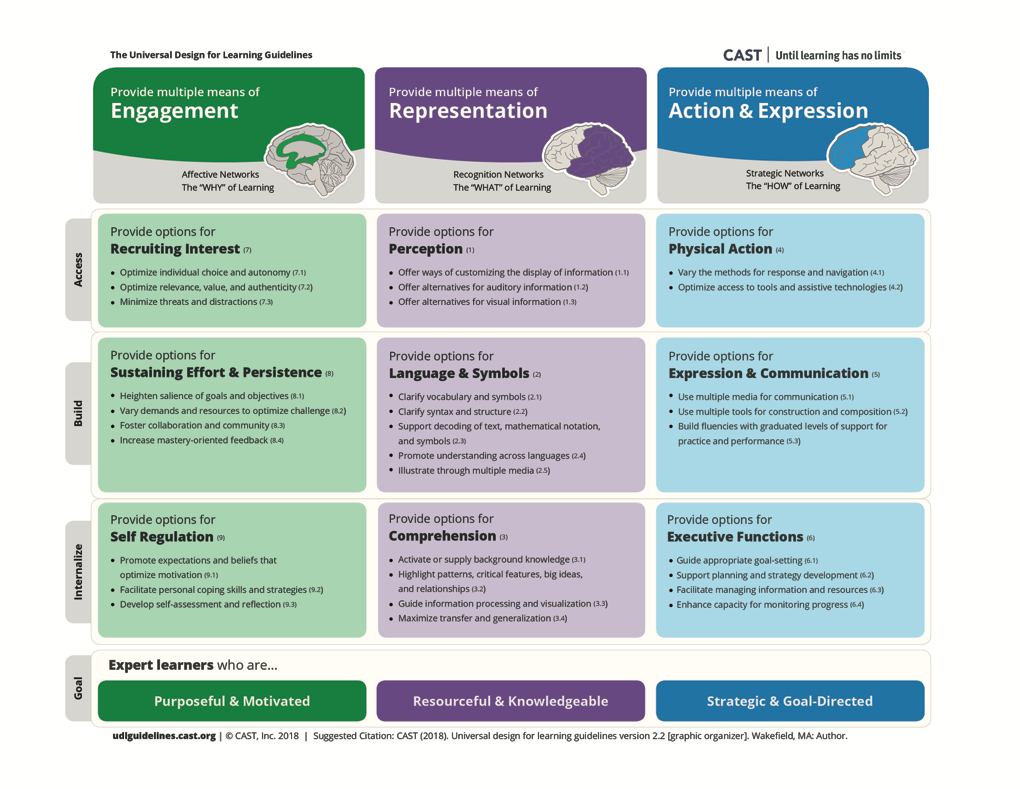
Possible approaches for an inclusive pedagogy
The table below shows some of the tools and strategies we put in place in the basic level French course, corresponding to the UDL guidelines. They can be applied to other disciplines.
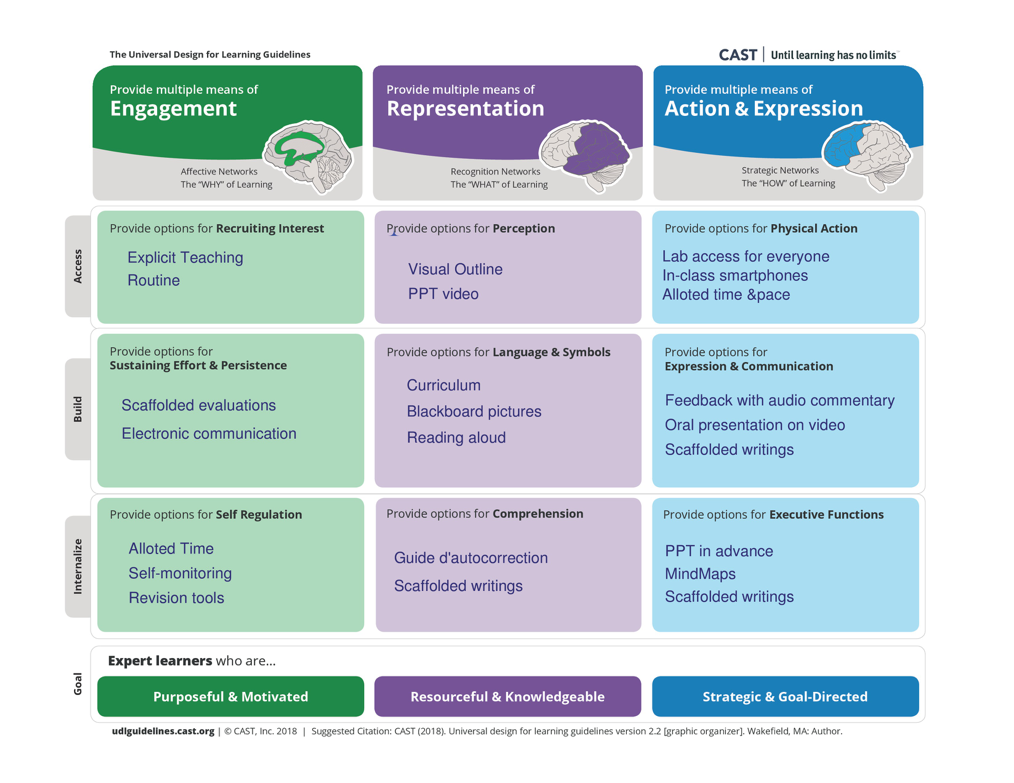
French as a second language (FSL)
In the instruction of French as a second language at the basic level (602-100-MQ, level I), emphasis is placed on the acquisition of grammar rules and on a series of exercises, tests, quizzes and written compositions. We found that even though the students were doing well on tests, there was no transfer when they wrote compositions. In order to write a sentence or a text in French, it is necessary to know the various elements of the sentence as well as their functions.
Drawing on this experience, we established a new way of presenting and teaching the subject based on the challenges and barriers encountered by our students when writing compositions. We eliminated the tests and quizzes and focused our evaluations on two series of compositions. The results of our research on the impact of UDL in the classroom show that there is an improvement in written French among all students, regardless of whether they have a disability (Galipeau, Konstantinopoulos, Soleil, PAREA-2018).
Scaffolding and systematization
Scaffolding[1] is a pedagogical technique that is planned in advance to support students in the stages of their learning and that also contributes to the grounding of UDL principles. When scaffolding is associated with the systemization of tools and learning strategies, it permits learners to make real progress.
During the semester, students in the course write two series of compositions. Each series consists of three compositions, each designed to be written while taking into account the previous one. The writing requirements and the competencies to be developed are progressively stepped within each series as well as between the two series. There are numerous objectives underlying the use of these progressive compositions:
- To better master the elements of basic sentences and their functions.
- To better understand and apply the rules of grammar.
- To make the student more independent in writing and revising texts.
- To develop a sense of satisfaction with writing in French.
These objectives are directly related to the competency elements and to the performance criteria established by the ministerial guidelines for the basic level French course.
The Guide d’autocorrection is a tool that enables students to review their composition by searching for the targeted evaluation criteria. It guides students through the process of questioning the structure of their basic sentences. It aims first to improve the understanding of the grammar rules that have been taught and to better correct the text. The Guide helps to systematize the automatic responses required for revision by guiding the processing and manipulation of the language throughout the student’s writing process. It allows students to structure the revision of their composition, a skill the vast majority of students lack at this level. It also enables students to reflect on their writing by focusing on the components of the evaluation. The Guide d’autocorrection gives students the necessary autonomy to apply revision strategies themselves.
In order to offer other means of scaffolding, we trained the students to use Antidote corrector software. It has the same function as the Guide d’autocorrection when students write in the computer laboratory.
Finally, for all assessments, the allotted time is sufficient so that all students can complete the task at their own pace. Given that time is not an evaluative criterion, students are then able to develop strategies of self-regulation and autonomy during their assessment and to undertake the required metacognitive tasks in the process of preparation, reflection and revision.
Teachers are an integral part of the scaffolding process, providing continuous feedback to students throughout their learning journey.
Flexibility, options and choices
Our goal as teachers in this student-centred pedagogy is to assist learners in becoming more autonomous and engaged. Flexibility in the choice of options is connected to self-regulation, and is one of the foundations of UDL. When applied to the learning of a language, flexibility in implementing a UDL guideline such as “action and expression” helps to remove barriers to learning. For example, a prepared oral presentation is a mandatory part of French evaluations but it is associated with many anxiety-provoking situations.
To offer greater flexibility to the student, while remaining equitable in terms of requiring action and expression, oral presentations can be given in front of a large group, in front of a small group, individually, and also in the format of a recorded video. The evaluation criteria are applied in the same way to both face-to-face and video formats. This flexibility in presentation format reduces the impact of anxiety without altering the evidence of a student’s oral competency. These options for completing required work are presented at the beginning of the course and are offered to all students, without distinction or requirement to produce a justification. This flexibility responds to the diversity of learners.
Finally, all our learning materials are accessible in advance and throughout the semester on the virtual platform of the course. Information that is available before class permits students to print or read documents to prepare for class. By having the outline of the lesson prior to the class, students can see what will be taught. They will be more prepared to process information and activate prior knowledge, thus allowing them to make connections with what they have already learned during the course. This approach also lowers the degree of anxiety (Turgeon, Brousseau, 2000). In addition, by using the teacher’s PowerPoint presentation as a framework for taking class notes, their required cognitive effort is thus reduced and they are able to focus more on processing information that is presented in the classroom and add information that is relevant to them.
Conclusion
The UDL model goes well beyond the application of sound pedagogical practices; it is a new way of thinking about inclusion as a whole and applying it systematically to teaching. Certainly, the development of a new mindset requires effort, discussion, thinking with a long-term perspective, and questioning one’s own values and beliefs, but it allows for building a solid, lasting, inclusive educational approach. From our experience in applying UDL and assisting other teachers to adopt this approach, UDL provides considerable satisfaction and recognition of effort to both learners and teachers.
If you would like further information please refer to UDL@Dawson.
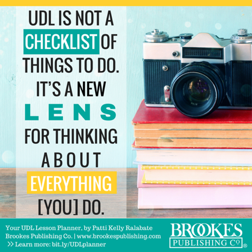
Footnotes
[1] Wood et al. (1976, p. 90) define scaffolding as a process “that enables a child or novice to solve a task or achieve a goal that would be beyond his unassisted efforts.” […] scaffolds require the adult’s “controlling those elements of the task that are initially beyond the learner’s capability, thus permitting him to concentrate upon and complete only those elements that are within his range of competence.”
References
Dubé, F., and Sénécal, M-N. (Fall 2009). « Les troubles d’apprentissage au postsecondaire: de la reconnaissance des besoins à l’organisation des services », Pédagogie collégiale, vol. 23 (1), 17-22.
Conseil supérieur de l’éducation (2017). Pour une école riche de tous ses élèves. S’adapter à la diversité des élèves, de la maternelle à la 5e année du secondaire, avis au ministre de l’Éducation, du Loisir et du Sport, Québec. At http://www.cse.gouv.qc.ca/fichiers/documents/publications/Avis/50-0500.pdf.
TÉLUQ, Wiki-TEDia, French record on Étayage (scaffolding). At http://wiki.teluq.ca/wikitedia/index.php/Etayage.
Turgeon, L., and Brousseau, L. (2000). “Prévention des problèmes d’anxiété chez les jeunes », in F. Vitaro and C. Gagnon (eds.), Prévention des problèmes d’adaptation chez les enfants et les adolescents, Montréal: Presses de l’Université du Québec.

